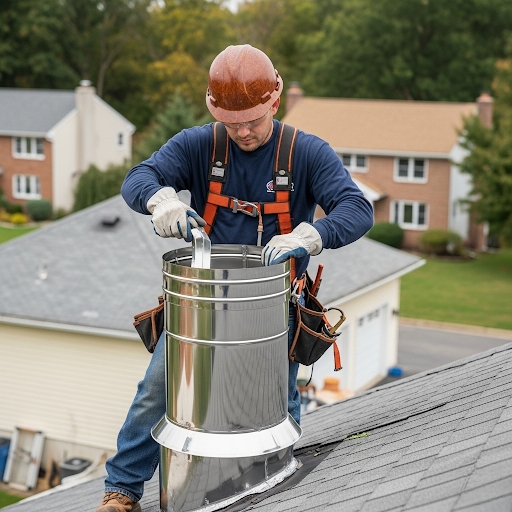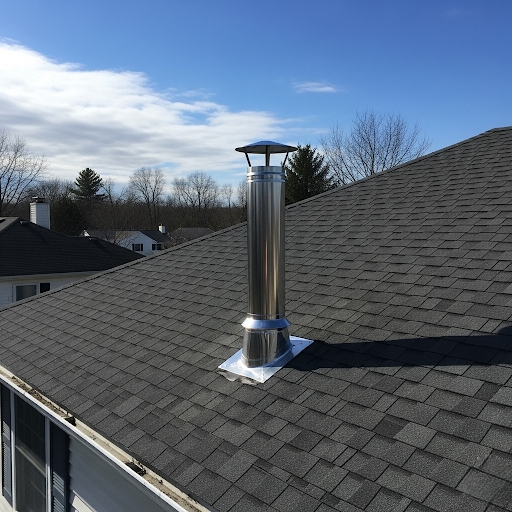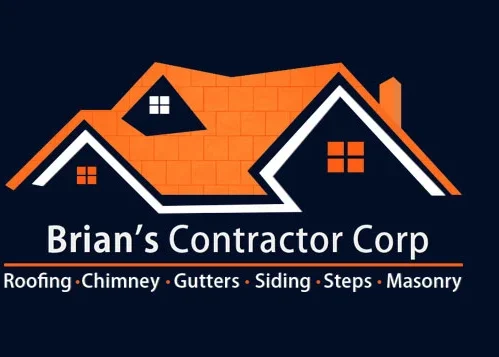
Did you know that many chimney-related house fires are caused by deteriorated or improperly installed chimney liners? In many cases, a stainless steel chimney liner can offer a durable, safe solution. Your chimney might look sturdy from the outside, but what’s happening inside could be putting your family at risk.
After inspecting thousands of chimneys across New York’s diverse housing stock, we’ve found stainless steel liners consistently outperform all alternatives in our harsh freeze-thaw climate cycles. With over two decades serving homeowners throughout the region, we’ve documented precisely how different liner materials hold up over time—and why stainless steel stands above the rest.
Let’s explore why stainless steel chimney liners have become the gold standard for safety-conscious homeowners and why choosing the right liner material matters more than you might think, especially when you’re already investing in professional chimney sweep services.
The Critical Comparison – How Different Chimney Liner Materials Stack Up
When evaluating chimney liner options, understanding the strengths and limitations of each material is crucial for making an informed decision. Not all liner materials are created equal, especially when facing New York’s demanding climate conditions.
Stainless steel liners are designed to withstand much higher temperatures than aluminum liners, making them a safer and more reliable choice for many chimney systems. Choosing the right material is essential to ensuring long-term performance and reducing fire risk.
Let’s examine how each common liner material performs in real-world applications.
Clay Tile Liners – Traditional But Troublesome
Clay tile liners have been used for generations and remain common in older New York homes. While these liners offer decent heat resistance, they present significant challenges in our region’s climate.
These traditional liners crack easily during the extreme freeze-thaw cycles common throughout New York state. When inspecting brownstones in Brooklyn and pre-war buildings in Manhattan, we consistently find fractures in clay liners that allow dangerous flue gases to escape into living spaces. These issues often require extensive chimney repair work that could have been avoided with better materials.
The mortar joints between clay tiles also deteriorate over time, creating additional vulnerability points. While clay liners might last 15-20 years in ideal conditions, we’ve documented their rapid failure in multi-story urban dwellings where heating demands are particularly high.
Aluminum Liners – Budget-Friendly But Brief Lifespan
Aluminum liners initially attract homeowners with their lower price point, but this seemingly cost-effective option often proves expensive in the long run.
In our experience servicing homes across Queens and Staten Island, aluminum liners typically show significant corrosion within just 5-7 years of installation. This material simply cannot withstand the acidic condensation produced by modern high-efficiency appliances, particularly in homes that have converted from oil to natural gas heating.
Temperature limitations present another critical concern. Aluminum begins to soften at temperatures that wood-burning fireplaces can easily exceed, creating a potential safety hazard that no homeowner should risk for minor upfront savings.
Cast-in-Place Liners – Solid But Restrictive
Cast-in-place liners create a solid, seamless flue by pouring cement-like material around a form inside your chimney. While these liners offer excellent durability in certain applications, they come with significant drawbacks.
The installation process is invasive and time-consuming, often requiring multiple days of work and creating considerable disruption. We’ve found that in many historic New York homes with irregular or damaged chimneys, the installation process can damage the existing structure, sometimes necessitating a complete chimney rebuild.
Additionally, once installed, these liners cannot be modified or easily replaced. Because of their rigid structure, cast-in-place liners are often unsuitable for modern heating system upgrades that require flexibility—something increasingly important for energy-conscious New York households.
Stainless Steel Liners – The Gold Standard for Performance
Stainless steel chimney liners have earned their reputation as the premier solution for virtually all residential applications. Available in both flexible and rigid configurations, these liners meet UL 1777 safety standards while offering unmatched versatility.
The continuous welding process used in quality stainless liners creates a seamless pathway for flue gases, eliminating the joint weaknesses found in clay tile systems. For Manhattan brownstones and Long Island Victorians alike, we’ve installed stainless steel liners that continue to perform flawlessly after decades of service.
Both 304 and 316-grade stainless steel options provide excellent corrosion resistance, with 316 marine-grade offering superior protection in coastal areas from Brooklyn to the Hamptons where salt air exposure accelerates deterioration of lesser materials.
5 Reasons Stainless Steel Chimney Liners Are Worth the Investment

While stainless steel liners typically require a higher initial investment than some alternatives, their value becomes unmistakable when you consider their comprehensive benefits and long-term performance.
Let’s examine why investing in a stainless steel chimney liner delivers exceptional value for New York homeowners.
Unmatched Durability in New York’s Harsh Climate
New York’s climate presents unique challenges for chimney systems, with freeze-thaw cycles, coastal salt exposure, and wide temperature fluctuations testing materials to their limits.
We’ve found that properly installed 316-grade stainless steel liners in coastal New York properties show virtually no corrosion even after 20+ years of exposure to salt air. This exceptional durability directly translates to peace of mind and protection for your home.
Unlike aluminum liners that begin deteriorating almost immediately in our climate, stainless steel maintains its structural integrity through harsh winters, humid summers, and everything in between. This resilience proves particularly valuable in older homes throughout the five boroughs and surrounding counties where chimney systems face heightened environmental stress.
Superior Safety Performance That Protects Your Home
Safety should never be compromised when it comes to your chimney system. Stainless steel liners excel in this critical area, providing multiple layers of protection for your family and property.
Properly lined chimneys significantly reduce the risk of fire compared to unlined or deteriorated systems. For most applications, stainless steel liners are considered one of the safest and most durable options available.
These liners effectively contain sparks and extreme temperatures, preventing them from reaching combustible materials in your home’s structure. The National Fire Protection Association consistently cites proper chimney lining as a key factor in preventing the chimney fires that damage thousands of homes annually.
When inspecting damaged chimneys after house fires, we frequently note that homes with intact stainless steel liners experience significantly less structural damage than those with deteriorated or inferior lining materials.
Cost-Effective Solution Over the Lifetime of Your Home
Analyzing the true cost of chimney liners requires looking beyond the initial price tag to consider long-term value.
While stainless steel liners may have a higher upfront cost than aluminum alternatives, their durability and long lifespan often make them a more cost-effective choice over time. For many homeowners, the reduced need for replacement and repairs can lead to significant long-term savings.
Additionally, homes with documented stainless steel chimney liner installations typically recover 100% of the installation cost during property resale, according to regional real estate valuation studies. This investment protection proves particularly valuable in New York’s competitive real estate market.
Versatility for All Heating Appliances and Fuel Types
Modern homes often use multiple heating systems or may transition between fuel types over time. Stainless steel liners accommodate these changes seamlessly.
Whether your home uses a wood-burning fireplace, gas furnace, oil burner, or pellet stove, stainless steel liners provide optimal performance and safety. This versatility proves particularly valuable as many New York homeowners transition from oil to natural gas systems in response to changing energy costs and environmental considerations.
In Brooklyn brownstones with multiple flues and heating systems, we regularly install stainless steel liners specifically because they adapt to various configurations and can be customized for unique structural requirements. When homeowners later upgrade their heating appliances, the existing stainless liners typically require no modification or replacement.
Professional Installation Ensures Maximum Performance
The full benefits of stainless steel liners depend on proper professional installation by certified chimney specialists.
Professional installation includes precise sizing calculations that optimize draft performance, improving heating efficiency while reducing fuel consumption. Our certified technicians follow ICC-certified installation protocols that exceed minimum code requirements, ensuring your system operates at peak performance.
During installation, experienced professionals can identify and address underlying structural issues that might otherwise go unnoticed. This comprehensive approach prevents costly surprises and ensures your entire chimney system functions properly.
What New York Homeowners Need to Know Before Choosing a Chimney Liner
Before making your decision about chimney liners, there are several critical factors that deserve careful consideration. Understanding these elements will help you make an informed choice that enhances your home’s safety and efficiency.
How can you tell if your current liner needs attention? What should you look for when selecting a chimney professional? Let’s address these important questions.
Signs Your Current Chimney Liner Needs Replacement
Recognizing the warning signs of chimney liner problems can help you address issues before they escalate into costly repairs or dangerous situations.
Watch for these tell-tale indicators that your chimney liner may need attention:
- White staining or efflorescence on exterior chimney brick (indicates moisture penetration)
- Flakes of metal or clay in your firebox or at the bottom of the chimney
- Strong odors coming from the fireplace when not in use
- Deteriorating mortar between chimney bricks
- Excessive smoke entering your home when the fireplace is in use
During our inspections throughout New York City and the surrounding counties, we frequently identify these warning signs in homes where occupants had no idea their chimney system was compromised. In most cases, these indicators appear long before complete failure, giving attentive homeowners the opportunity to address problems proactively.
Have you noticed water stains on walls or ceilings near your chimney? This often indicates that liner damage has already led to moisture penetration through the chimney structure—a situation that demands immediate professional assessment.
Choosing the Right Chimney Professional in New York
Selecting a qualified chimney specialist is perhaps as important as choosing the right liner material. With so many service providers in the New York area, how can you identify truly qualified professionals?
When evaluating chimney service providers, look for these essential qualifications:
- CSIA (Chimney Safety Institute of America) certification
- Proper insurance and licensing specific to New York state requirements
- Membership in professional organizations like the National Chimney Sweep Guild
- Specific experience with stainless steel liner installations
- Detailed written estimates and clear contracts
- Willingness to pull necessary permits and coordinate inspections
Be cautious of contractors offering significantly lower prices than others, as this often indicates cutting corners on materials or installation quality. Quality installation by certified professionals ensures you receive the full safety and performance benefits of your stainless steel liner.
Understanding the Installation Process and Timeline
Knowing what to expect during the installation process helps you prepare appropriately and ensures you can evaluate whether the work is being performed correctly.
A professional stainless steel chimney liner installation typically follows these steps:
- Comprehensive initial inspection, often including camera assessment of the existing flue
- Precise measurements and customization of the liner to your specific chimney
- Protection of your home’s interior during the installation process
- Removal of any existing damaged liner materials
- Installation of the new liner, typically from the roof down
- Connection to heating appliances with proper fittings
- Insulation application when required for optimal performance
- Final inspection and testing of the complete system
For a typical single-flue chimney in a New York home, the entire process usually requires 1-2 days, depending on complexity and weather conditions. Older homes in Manhattan and Brooklyn with multiple flues or unusual configurations may require additional time.
When scheduling your installation, consider seasonal timing. Fall sees extremely high demand for chimney services throughout New York, often resulting in extended wait times. Planning your installation during spring or summer typically provides more scheduling flexibility and ensures your system is ready before the heating season begins.
Why We Recommend Stainless Steel Chimney Liners for Every New York Home
After installing and servicing thousands of chimney liners across New York over the past two decades, we’ve developed an unshakable confidence in stainless steel’s superiority for our unique regional conditions.
The initial investment in a quality stainless steel liner translates directly to decades of reliable performance, improved heating efficiency, and most importantly, enhanced safety for your family. When considering chimney restoration projects, investing in quality materials from the start can prevent costly repairs later. When you consider the potential consequences of chimney failure—from costly water damage to catastrophic house fires—the choice becomes clear. Learn more about chimney and how to protect your home—visit our blog for expert insights.
Ready to explore whether a stainless steel chimney liner is right for your home? Contact our CSIA-certified chimney contractors for a comprehensive inspection and personalized recommendation. We’ll help you understand your options and make the choice that best protects your family and property for decades to come.
Your home deserves nothing less than the gold standard in chimney safety and performance—and in New York’s demanding environment, that standard is unquestionably stainless steel.


